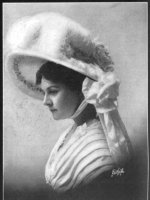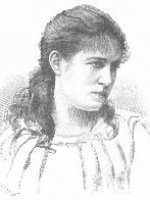Germaine Dulac is a Director, Scriptwriter and Supervising Art Director French born on 17 november 1882 at Amiens (France)
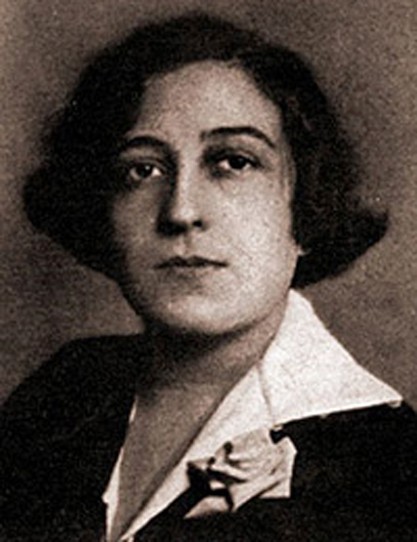
Germaine Dulac ([dylak]; born Charlotte Elisabeth Germaine Saisset-Schneider; 17 November 1882 – 20 July 1942) was a French filmmaker, film theorist, journalist and critic. She was born in Amiens and moved to Paris in early childhood. A few years after her marriage she embarked on a journalistic career in a feminist magazine, and later became interested in film. With the help of her husband and friend she founded a film company and directed a few commercial works before slowly moving into Impressionist and Surrealist territory. She is best known today for her Impressionist film, La Souriante Madame Beudet ("The Smiling Madam Beaudet", 1922/23), and her Surrealist experiment, La Coquille et le Clergyman ("The Seashell and the Clergyman", 1928). Her career as filmmaker suffered after the introduction of sound film and she spent the last decade of her life working on newsreels for Pathé and Gaumont.
Following her long and influential cinema career, Dulac became the president of the Fédération des ciné-clubs, a group which promoted and presented the work of new young filmmakers, such as Joris Ivens and Jean Vigo. Dulac also taught film courses at the Ecole Technique de Photographie et de Cinématographie on the rue de Vaugirard. Following her death in 1942, Charles Ford called attention to the difficulty the French Press had with printing her obituary:
"Bothered by Dulac’s non-conformist ideas, disturbed by her impure origins, the censors had refused the article which, only after vigorous protest by the editor-in-chief of the magazine, appeared three weeks late. Even dead, Germaine Dulac still seemed dangerous.
Source : Wikidata
Germaine Dulac

Birth name Germaine Saisset-Schneider
Nationality France
Birth 17 november 1882 at Amiens (France)
Death 20 july 1942 (at 59 years) at Paris (France)
Nationality France
Birth 17 november 1882 at Amiens (France)
Death 20 july 1942 (at 59 years) at Paris (France)
Biography
Germaine Dulac was born in Amiens, France into an upper-middle-class family of a career military officer. Since her father's job required the family to frequently move between small garrison towns, Germaine was sent to live with her grandmother in Paris. She soon became interested in art and studied music, painting, and theater. Following the death of her parents, Dulac moved to Paris and combined her growing interests in socialism and feminism with a career in journalism. In 1905 she married Louis-Albert Dulac, an agricultural engineer who also came from an upper-class family. Four years later she began writing for La Française, a feminist magazine where she eventually became the drama critic. Dulac also found time to work on the editorial staff of La Fronde, a radical feminist journal of the time. She also began to pursue her interest in still photography, which preceded her initial entry into filmmaking. Dulac and her husband divorced in 1920.Following her long and influential cinema career, Dulac became the president of the Fédération des ciné-clubs, a group which promoted and presented the work of new young filmmakers, such as Joris Ivens and Jean Vigo. Dulac also taught film courses at the Ecole Technique de Photographie et de Cinématographie on the rue de Vaugirard. Following her death in 1942, Charles Ford called attention to the difficulty the French Press had with printing her obituary:
"Bothered by Dulac’s non-conformist ideas, disturbed by her impure origins, the censors had refused the article which, only after vigorous protest by the editor-in-chief of the magazine, appeared three weeks late. Even dead, Germaine Dulac still seemed dangerous.
Usually with
Filmography of Germaine Dulac (26 films)
Director

Ceux qui ne s'en font pas (1930)
Directed by Germaine Dulac
Origin France
Mise en images de chansons de Fréhel
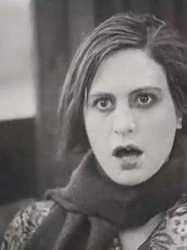
Those Who Worry (1930)
, 6minutesDirected by Germaine Dulac
Origin France
Genres Musical
Actors Lilian Constantini
Rating65%





Mise en images de chansons de Fréhel (Toute seule et À la dérive), qui se répondent en décrivant des femmes victimes de leur soumission à l'homme.
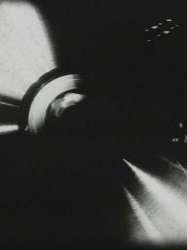
Disque 957 (1929)
, 6minutesDirected by Germaine Dulac
Origin France
Genres Musical
Rating69%





Impressions visuelles. En écoutant les 5e et 6e Préludes de Frédéric Chopin.
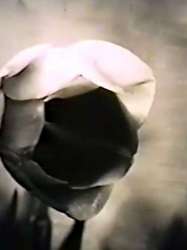
Arabesque (1929)
, 5minutesDirected by Germaine Dulac
Origin France
Genres Fantasy
Rating63%





Variations sur le thème de l'arabesque.

Themes and Variations (1928)
, 9minutesDirected by Germaine Dulac
Origin France
Genres Action
Rating67%





Alternance de plans présentant d'une part une danseuse classique en tutu et d'autre part une machine avec bielles, pistons, etc.

Princesse Mandane (1928)
, 1h14Directed by Germaine Dulac
Origin France
Genres Adventure
Actors Mona Goya, Yvonne Legeay, Christian-Gérard, Edmond van Daële
Rating68%





Étienne Pindère, un contremaître, est fiancé à Anna, secrétaire dans la même usine. Il rêve d'aventures et un jour il décide de partir en mission pour la Mingrélie, pays gouverné par la princesse Mandane. Il s'endort en attendant ses équipiers et rêve que, devenu riche, il rencontre la princesse qui est prisonnière dans son pays, et qui rêve de partir pour Paris. Elle demande à Pindère de l'aider. Il la conduit jusqu'à la frontière. Et c'est à ce moment de son rêve qu'il est réveillé et qu'il retrouve Annette qui a décidé de partir avec lui.

Antoinette Sabrier (1927)
, 1h20Directed by Germaine Dulac
Origin France
Genres Drama
Themes Théâtre, Films based on plays
Actors Ève Francis, Gabriel Lelièvre, Jean Toulout, Paul Guidé, Paul Menant
Antoinette Sabrier est mariée au magnat du pétrole Germain Sabrier, mais elle se sent délaissée par son mari et se lance bientôt sur une histoire d'amour clandestine avec René Dangenne. Jamagne, lui aussi amoureux d'Antoinette, décide de les ruiner pour se venger. Face à ce problème, Antoinette est réticente à quitter son mari. Forcée de choisir entre René et Germain, elle met de côté ses sentiments et revient aux côtés de son mari.

Invitation to a Journey (1927)
, 40minutesDirected by Germaine Dulac
Origin France
Genres Drama
Themes Poésie, Adaptation d'un poème
Actors Lucien Bataille
Rating69%





Une femme, lasse de la routine familiale et d'un mari toujours en voyage d'affaires, s'aventure un soir dans le cabaret "L'invitation au voyage", fréquenté par des marins et des femmes à la mode. Son regard croise celui d'un jeune officier. Ils dansent ensemble, il lui fait la cour, elle commence à rêver à une autre vie, loin, dans un pays exotique, mais le marin remarque l'alliance à son doigt et voit une photographie de son enfant dans son sac. Il répond alors à l'invitation d'une entraîneuse et la jeune femme est obligée de revenir à la réalité de sa vie ordinaire.
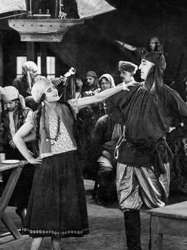
The Madness of the Valiants (1926)
, 45minutesDirected by Germaine Dulac
Origin France
Genres Drama
Rating65%





Les amours tragiques de Loïko et de la tzigane Radda.
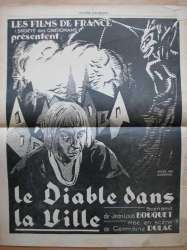
The Devil in the City (1925)
, 1h20Directed by Germaine Dulac
Origin France
Genres Drama, Fantasy, Historical
Actors Léon Mathot, René Donnio, Émile Saint-Ober, Lucien Bataille
Rating62%





Au XV siècle dans une petite ville imaginaire. Des contrebandiers se sont installés dans la Tour Grise, une partie des remparts abandonnée depuis longtemps. Mais, un jour, le bailli décide de mettre en vente la tour pour combler une partie des dettes de la ville. Personne ne se porte acquéreur jusqu'à ce que Marc Herner, un étranger, arrive et l'achète pour s'installer en ville, étant tombé amoureux d'une habitante. Les contrebandiers font alors courir le bruit que c'est un magicien et, pire encore, un envoyé du Diable.

Heart of an Actress (1924)
Directed by Germaine Dulac
Origin France
Genres Drama, Romance
Actors Iván Petrovich, Nicolas Koline, Yvette Andréyor, Henry Houry, Gina Manès, Jeanne Bérangère
Rating68%






Gossette (1923)
Directed by Germaine Dulac
Origin France
Genres Drama, Comedy
Actors Maurice Schutz, Madeleine Guitty, Jean d'Yd, Paul Menant, Jeanne Brindeau
Rating31%





Une jeune orpheline est recueillie par un couple dont le fils, faussement accusé de meurtre, est en fuite. Lorsque les parents sont tués à leur tour, leur fils et la jeune fille parviennent, après bien des péripéties, à démasquer le vrai coupable. Tout finit par un mariage.

The Smiling Madame Beudet (1923)
, 38minutesDirected by Germaine Dulac
Origin France
Genres Drama
Themes Feminist films, Politique, Théâtre, Political films, Films based on plays
Actors Germaine Dermoz, Alexandre Arquillière, Jean d'Yd, Madeleine Guitty
Rating65%





Madame Beudet is used to Monsieur Beudet playing a stupid practical joke. A frequent stunt is one in which he puts an empty revolver to his head and threatens to shoot himself. After getting into an argument with Monsieur Beudet, she secretly puts bullets into the revolver, hoping that he will accidentally kill himself next time he pulls the same practical joke. However, after a sleepless night she becomes stricken with remorse and tries secretly to retrieve the bullets the next morning. Unfortunately Monsieur Beudet gets to the revolver first, thinking the revolver is empty as usual, and this time he points the revolver at her and shoots. The bullet misses her, and he thinks she was trying to commit suicide; he embraces her and says "How could I live without you?"
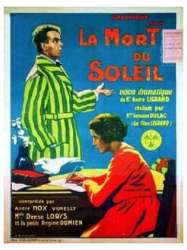
The Death of the Sun (1922)
, 1h36Directed by Germaine Dulac
Origin France
Genres Drama
Actors André Nox, Denise Lorys, Louis Vonelly, Jeanne Bérangère, Jeanne Brindeau
Rating56%





Une jeune doctoresse est l'adjointe d'un grand spécialiste de la tuberculose. Son mari, jaloux, lui demande de choisir entre sa famille et son métier.
 , 1h20
, 1h20Directed by Germaine Dulac
Origin France
Genres Drama, Romance
Actors Jean Toulout, Denise Lorys, Jean Tarride
Rating62%





 Connection
Connection

